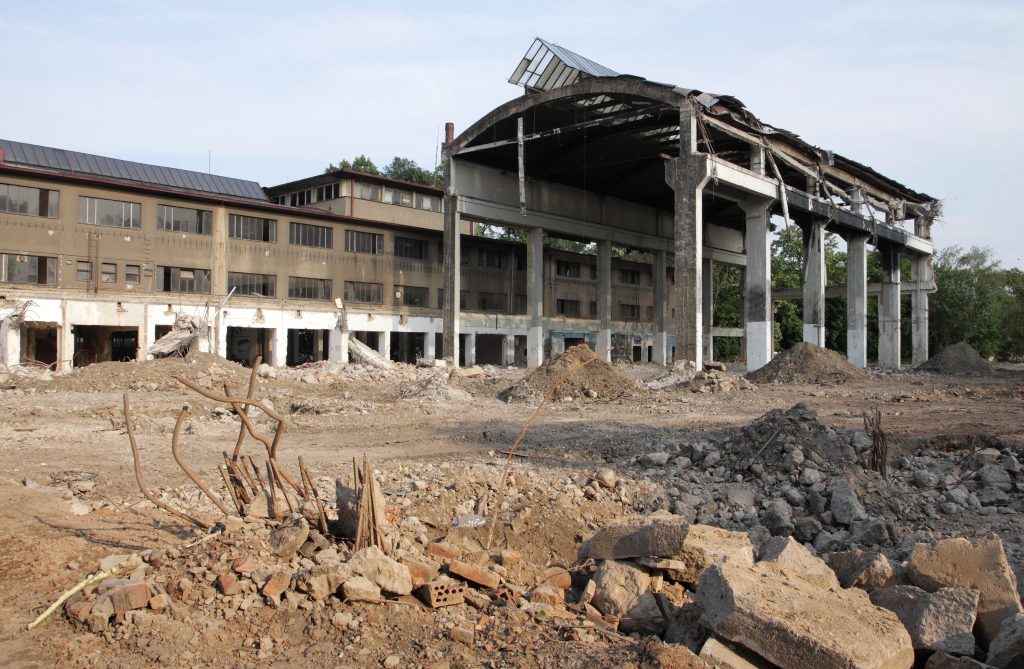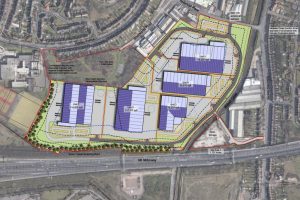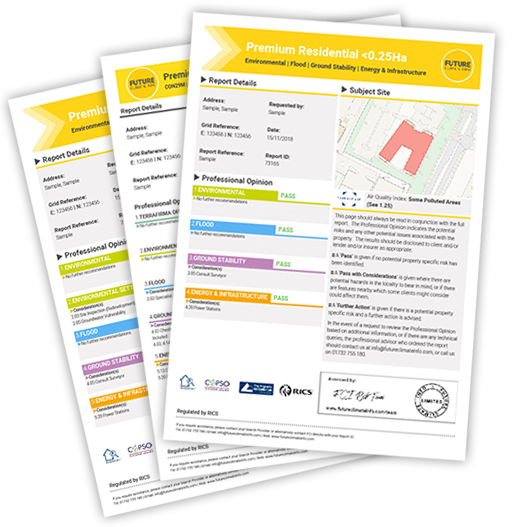
Walsall: A Phoenix from the Ashes
One of the most contaminated sites in Europe is to receive a multi-million pound clean up in the hope of creating thousands of jobs for the West Midlands.
The land in Walsall, between M6 junctions 9 and 10, has been chosen by the West Midlands Combined Authority (WMCA) to be cleaned up and turned into an industrial park.
Spanning 44 acres, the site has been derelict for more than 20 years and an eyesore for motorway users. It was even considered for opencast mining as one solution in its long and chequered history, after the headquarters of James Bridge Copper Works was closed in 1999.
Known as the Phoenix 10 Scheme, the investment is thanks to a deal between the WMCA, Walsall Council, Homes England, the Black Country Local Enterprise Partnership and Henry Boot Development. It is one of the key projects now going ahead through the Land and Property Investment Fund.

Picture: Phoenix 10 scheme outline – courtesy of Bowman Riley
Catalyst for Regeneration
The development is set to provide around 620,000 sq ft of employment floor space across the site. It is expected to create around 1,000 temporary construction jobs and more than 1,100 full-time jobs once completed and occupied.
In parallel, the nearby Walsall to Wolverhampton rail line is set to be re-opened. New stations will be built at Willenhall and Darlaston to unlock further derelict land for industry and housing in the Black Country Enterprise Zone.
The site, which is currently jointly owned by Homes England and Walsall Council, is the largest potential employment site in the Black Country. It is also one of the largest brownfield employment opportunities in the West Midlands.
The site is surrounded by development and infrastructure. The eastern part of the site is bounded by West Walsall Academy, with a park and light industrial units to the north. The Walsall canal bounds the southern extent of the site with the M6 situated along the western boundary.
The western portion of the site will be subject to the remedial works for the site. However, no development is proposed on this land parcel.
Wide Range of Sensitivities
Concerns have been raised in the recent past from local residents about sensitivity to the local community and college. They fear the development will compound air quality issues from the nearby M6 motorway, plus dust and movement of contaminants and gas migration from the soils.
In April 2018, a detailed Environmental Impact Assessment (EIA) Scoping Report was produced by BWB Consultants on behalf of Henry Boot Developments Ltd.
It is clear from the report submitted to Walsall Council that the site is a complex one in terms of sensitive receptors:
- Groundwater within Coal Measures, Superficial Alluvial Deposits and Glacial Deposits
- Surface waters in the River Tame, Sneyd Brook, the Walsall Canal the Lord Bradford Surface Water Discharge;
- Nearby residential properties and occupiers/users in Primley Avenue and Darlaston Road
- Nearby commercial properties and occupiers/users in Reservoir Place, Woodwards Road and Bentley Mill Way
- Recreational users of the Walsall canal
- Direct transfer of contaminated wastes/soils and gas generation
Contaminant Profile
There are areas of in-filled land and made ground to depths from 2 to 12M. These comprise a mixture of domestic refuse; reworked mudstone/clay with some ash and demolition materials; and ash, clinker, slag and demolition waste. There are also deeper areas of Made Ground, which include waste materials from the former refinery operations.
Heavy metals, hydrocarbons, cyanides and asbestos are in excess of those permitted for commercial/industrial end use, but are confined to ‘hotspots’.
Elevated levels of heavy metals are present in the groundwater, especially in two separate layers of ‘worked-out’ coal seams where the impacts are greatest. Ground gas from the coal seams is not anticipated to be an issue.
To the west of the M6, there is a further area of infilling but with waste materials from the former works itself. The landfill is up to 11m in depth with the waste comprises slag, sludge, pressed effluent, asbestos-cement and scrap rubber. It is located adjacent to and raised at a higher elevation than the adjacent River Tame and has an overflow discharge to this water course.
A redundant toe drain runs parallel with the watercourse. Historically, it was used to control leachate emerging from the face of the landfill. Unsurprisingly, groundwater is impacted within both the superficial river valley deposits and in the Coal Measures and represents an on-going risk to surface water quality.
Proposed Remediation Strategy
BWB have recommended a comprehensive, multi-faceted strategy, which involves the following elements:
- Excavate the Soil/Made Ground to a suitable level to expose the former coal mine entries and shallow workings, so that they can be remediated.
- Grout the coal seams to provide a solid alkaline mass that immobilises and neutralises the existing heavy metals
- Excavate soils, then screen, crush and reuse in accordance with a Materials Management Plan (under the CL:AIRE Definition of Waste: Development Industry Code of Practice). Replace in accordance with the earthworks specification for the proposed site wide development
- ‘Hotspots’ will be managed on-site by further sampling. Ex situ bio-remediation or cement-based solidification is the probable strategy for these isolated areas of soil impact.
- On the Western side of the site, cap the waste to limit further infiltration and improve drainage to prevent leachate entering surface water.
- Should an on-going risk to surface water quality persist, a permeable reactive barrier will be installed between the water course and the landfill to provide a ‘filter’ that would remove metal contamination before it can enter the watercourse.
The strategy will be subject to further assessment and agreement with the Planning Authority and Environment Agency as part of the planning submission process.
A hybrid planning application (part full and part outline) is expected to be submitted during the summer.
It will cover the demolition of the existing buildings, site remediation and creation of development platforms. It will also include outline application for development of employment buildings, landscaping and open space. It will also detail internal roads and footways, parking and service areas, balancing ponds and associated utilities and infrastructure.
Accounting for Future Drainage and Ecology
Work on cleaning up the land is expected to start in 2020. A key aspect of the remediation will not only be the contaminant removal but also the complex interrelationship between groundwater, surface and drainage water, the recreational uses and ecological impacts along the canal.
Should sustainable drainage systems (SuDS) also be deployed in the final development design, as is likely, this will further strengthen the requirement to cap, contain or remove the threat of contaminant transmission.
Add to that the impact of localised flooding and revisions to climate change allowances within zoning for land use. All these factors will need to be taken into account in an holistic approach to environmental impact and the remediation strategy that is delivered.
We will update you on progress as the site remediation gets underway.
Try before you buy
To take advantage of a trial free order of your first environmental report, please complete the enquiry form and we will get back to you as soon as possible. We will need to take more details of the property or site and ask some more questions about your firm and the transaction.

